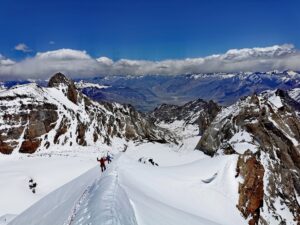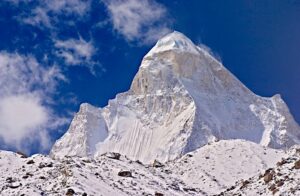A growing closeness between China and Nepal will culminate in a railway linking the two countries through the Himalaya
As Everest climbers prepare for their south-side expeditions and buy their plane tickets to Nepal, Tibet maintains a stony silence. By now, international operators have given up hope of launching expeditions to Everest North Side, Cho Oyu or Shishapangma.
Nor has any news surfaced about even local (Chinese) teams heading that way. In fact, many Chinese nationals have chosen Nepal as their spring climbing destination.
But Nepal and China have agreed to bridge the divide in at least one way.
Despite the daunting physical barrier of the Himalaya, planning is underway to build a cross-border railway connecting China’s Tibet autonomous region with Nepal’s capital, Kathmandu, according to the China Daily. This is the latest in several ways that the two countries have recently moved closer together. Next year, China will help fund an industrial park in Jhapa, in eastern Nepal. And communication between the two nations is more open, even if the path to Everest’s North Side remains closed.
The new alliance began in 2019 when China’s President Xi Jinping paid a state visit to Nepal. It was the first by a Chinese president in 23 years. China and Nepal then elevated their relationship to a strategic partnership. Former Nepali Prime Minister Baburam Bhattarai declared that “new vistas” for bilateral cooperation had opened up. Months later, when the COVID pandemic struck, China was quick to send PPEs and medical supplies. Both Jack Ma and his Alibaba Foundation made juicy donations to the country.
This new railway forms part of the Trans-Himalayan Multi-Dimensional Connectivity Network, to which China and Nepal agreed in 2017. It’s part of China’s gigantic project to build what they call the New Silk Road connecting Eurasia by land and sea: by train from Shanghai to Madrid or Istanbul, and Beijing to St. Petersburg, and via a maritime belt skirting the temperate parts of the continent (only avoiding the Arctic, for now).

The New Silk Road designed by China, linking Eurasia and Africa. Map: Friedrich Ebert Stiftung
Recently, Nepal and China’s increasing cooperation also extended to mountaineering, with their joint announcement of Everest’s new height, as well as the Chinese 5G network on the Tibetan side of Everest. Last spring, shortly after the pandemic shut down the world, only a Chinese surveying team made it to the summit of Everest.
During this expedition, climbers and scientists, aided by Chinese authorities, used cutting-edge technology to remeasure the mountain, but also turned the area into a 5G hotspot, thanks to ChinaMobile and Huawei.
Although not confirmed, there is no reason why the 5G network would not still be operating. If so, cell coverage will reach part of the south side route too. The same technology also let Chinese television install a webcam that streams images of the mountain from near the Rongbuk Monastery.
China and Nepal (which had launched a similar expedition a year earlier) even shared their calculations about the height of Everest and announced the new figure together: 8,848.86m.
In China, there is a growing interest in outdoor activities in general and in mountaineering in particular, thanks to the emergence of a middle class with higher income and more leisure time. Already, the Chinese Mountaineering Association includes 400 mountain or climbing clubs.

Ice climbing in Xi’an province. Photo: China Daily






